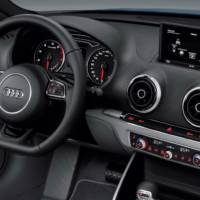Drawing inspiration from the new Audi A3 Saloon with its flowing lines and finely balanced proportions, the all-new A3 Cabriolet makes its world public debut at the 2013 Frankfurt Motor Show. The compact class open-top will become available for UK ordering in late October, and will reach its first customers here in March 2014.The all-new A3 Cabriolet makes its world public debut at the 2013 Frankfurt Motor Show next week, and will become available for UK ordering in late October ahead of first deliveries in March 2014.
To achieve its sleeker profile and provide the capacity for complete soft-top concealment when in open mode, the new compact class cabriolet has grown compared to the previous model: its length has increased from 4.24 to 4.42 metres, its wheelbase from 2.58 to 2.60 metres and its width from 1.77 to 1.79 metres. Only its height (1.41 metres) is down on its predecessor, by 15 millimetres. Luggage capacity has also grown by 60 litres (2.12 cubic ft), and access to that space has been improved.
The front of the Audi A3 Cabriolet is characterised by the single frame radiator grille, which is flanked by flat headlamps that can light the way using either halogen or xenon bulbs depending on version, or using optional LED headlamp technology.
The rear overhang plays a key role in the harmonious proportions of the two-door car. The windscreen frame is made of aluminium – and an aluminum-look trim strip runs around the roof aperture. On the flanks, the design features a taut tornado line and contoured surfaces that take full advantage of light and shadow.
The new A3 Cabriolet has a soft fabric roof that is stretched over a lightweight kinematic mechanism made of magnesium-steel, and it complements the car’s design perfectly. At the press of a button, the top opens or closes electro-hydraulically in less than 18 seconds at speeds of up to 31mph. When retracted, the top – folded into three layers – rests in a tray that barely affects luggage capacity, which is 287 litres.
The new Audi A3 Cabriolet is around 50 kilograms lighter than the previous model despite its larger size and improved comfort – the kerb weight of the entry-level version is just 1,365 kilograms. Even taking into account its special reinforcements, which deliver high torsional rigidity, the body-in-white with its aluminium bonnet weighs 30 kilograms less than previously. Weight was also significantly reduced in the interior and in the engines, contributing to best-in-class figures which bear testament to the Vorsprung durch Technik brand’s intensity of focus on lightweight construction principles.
The cabin offers enough space for four adults, and the seatbacks of the two rear seats can be folded down to create a wide through-load area. The steering wheel and seats are new designs, and the new electro-mechanical parking brake is operated by a button on the centre console. Depending on which of the three trim levels – SE, Sport and S line – is chosen by UK customers, the seats are finished in either cloth or a combination of cloth and leather, with full leather and an Alcantara/leather mix available on the options list.
Three newly developed engines will be offered in the Audi A3 Cabriolet at its launch, all placing the emphasis as much on performance as on efficiency. The two TFSI engines produce 140PS and 180PS from 1.4 and 1.8 litres of engine displacement, respectively, while the 2.0 TDI develops 150PS; other engines will follow – ranging from the 1.6 TDI with 110PS to the 2.0 TFSI, which will power the Audi S3 Cabriolet with 300PS. All engines in the new Audi A3 Cabriolet employ direct injection and turbocharging and are backed up by a start-stop-system.
On average, the three launch engines bring a fuel economy improvement of around 12 per cent compared with their closest equivalents in the previous A3 Cabriolet range, despite also making performance gains. The 1.4 TFSI with six-speed manual transmission, for example, powers the new car from 0 to 62mph in 9.1 seconds, yet also achieves a very healthy 56.5 mpg with CO2 emissions of 114 g/km. Also contributing to this efficiency is Audi cylinder on demand (COD) technology, which deactivates two of the engine’s cylinders in low load conditions.
The 1.8-litre TFSI is also a state-of-the art unit with an extensive package of high-end technologies, including dual injection into the combustion chambers and induction manifold. It is initially linked exclusively to a seven-speed S tronic twin-clutch transmission, and where the Audi drive select vehicle dynamics system is fitted, it offers a free-wheeling function that further improves fuel economy. According to the combined cycle test it is capable of returning up to 48.7 mpg with CO2 emissions of 133g/km.
Not surprisingly the manual transmission-equipped 2.0 TDI with 150PS remains the economy champion in the first phase of engines, offering combined fuel consumption of 67.3 mpg and CO2 emissions of 110g/km.







